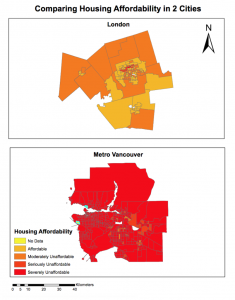
Housing affordability is measured in comparison to household incomes. According to United Nations, “If there is a single indicator that conveys the greatest amount of information on the overall performance of housing markets, it is the house price-to-income ratio.” In other words, the price-to-ratio is used to measure the middle-income housing affordability in housing markets. Using Housing cost markets instead of the neighborhoods due to it represents the selection of housing that is locally available to households. Housing affordability is a better indicator as it is an essential consideration for the people in the city “to seek a better opportunities and to companies evaluating economic factors in making facility location decisions.” (13th Annual Demographia International Housing Affordability Survey 2017) The maps reveal the housing affordability in London and Metro Vancouver that London is more affordable than the Metro Vancouver.
The Demographia International Housing Affordability Survey uses the price-to-income ratio to determine the multiple median. The multiple median measures the middle-income housing affordability while the price-to-income ratio is based upon the United Nations schemes. However, the affordability categories are not trustworthy. It is because different data classification can show us different visual impressions on the map. It depends on what rating categories we use and what data classification break we use. If we use the housing costs instead of the housing affordability, the result will be totally different.
In my opinion, housing affordability is not a good indicator to rank the ‘livability’ of a city. Although housing is our basis needs for living and accommodation, if the citizens cannot afford this basic human needs, more and more conflicts will result due to the rising housing price. The ‘livability’ of a city should not be ranked only base on the housing costs or affordability, there are many different perspectives or indicators to consider such as the infrastructures and facilities like transit system, recreational parks, hospitals; government policies, tax policies, safety, environments, etc. Housing costs or affordability should not be the only indicator to represent the ‘livability’ of a city.